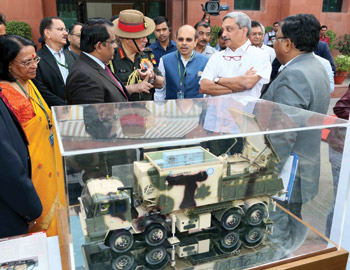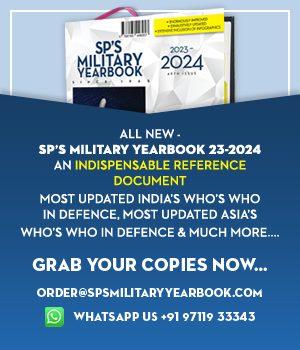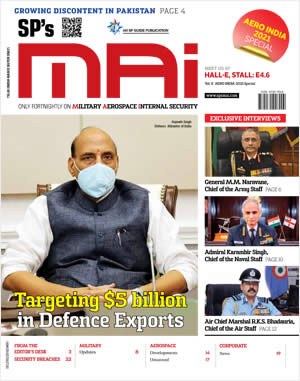INDIAN ARMED FORCES CHIEFS ON OUR RELENTLESS AND FOCUSED PUBLISHING EFFORTS

The insightful articles, inspiring narrations and analytical perspectives presented by the Editorial Team, establish an alluring connect with the reader. My compliments and best wishes to SP Guide Publications.

"Over the past 60 years, the growth of SP Guide Publications has mirrored the rising stature of Indian Navy. Its well-researched and informative magazines on Defence and Aerospace sector have served to shape an educated opinion of our military personnel, policy makers and the public alike. I wish SP's Publication team continued success, fair winds and following seas in all future endeavour!"

Since, its inception in 1964, SP Guide Publications has consistently demonstrated commitment to high-quality journalism in the aerospace and defence sectors, earning a well-deserved reputation as Asia's largest media house in this domain. I wish SP Guide Publications continued success in its pursuit of excellence.
- Appointments Committee of Cabinet approves one-month extension in service of Chief of the Army Staff
- Admiral Dinesh K. Tripathi assumes Command of the Indian Navy as 26th Chief of the Naval Staff
- Prime Minister witnesses 'Bharat Shakti' – a Tri-Services Firing and Manoeuvre Exercise in Pokhran, Rajasthan
- Interim Defence Budget 2024-25 — An Analysis
- Union Defence budget 2024
- Prime Minister Modi Commemorates Indian Navy Day in a Grand Ceremony
DRDO hands over its products to Indian Army

The Defence Research and Development Organisation (DRDO) handed over three of its products for induction into the Indian Army in a formal function here recently. The products — Weapon Locating Radar (WLR) Swathi; NBC Recce Vehicle and NBC Drugs. Defence Minister Manohar Parrikar handed over the products to the Chief of the Army Staff General Bipin Rawat on behalf of DRDO.
The Defence Minister congratulated DRDO for the series of recent trials including the interceptor missiles. He complimented DRDO scientists for handing over equipment to the Indian Army. Parrikar said that DRDO, defence forces, PSUs and private sector industry’s partnership can be a game changer in the near future.
General Bipin Rawat after receiving the products complimented the DRDO for achieving another milestone in their continuing success stories. He was optimistic that at this speed, modernisation of the Indian Army would move at a much faster pace.
The DRDO Chairman and Secretary Department of Defence R&D Dr S. Christopher said: “After Navy and Air Force, time has now come to handover our products to the Army and it is a proud moment for all scientists in DRDO”. He stressed that the co-development approach of involving DRDO, user and the industry would speed up projects.
DRDO has been developing a number of products for the Indian Army in support of their field operations and welfare of soldiers on ground. Many of these products have been inducted and are presently operational in field units. In 2016, the Weapon Locating Radar, NBC Recce Vehicle and a set of NBC Drugs had been successfully tested after extensive evaluation by competent evaluation teams/bodies.
Weapon Locating Radar Swathi, developed by DRDO’s Electronics & Radar Development Establishment (LRDE), provides fast, automatic and accurate location of all enemy weapons like mortars, shells and rockets firing within its effective zone of coverage and simultaneously handles multiple projectiles fired from different weapons at different locations. The system is capable of adjusting the fire of our own artillery weapon also. The weapon includes 81mm or higher calibre mortars, 105mm or higher calibre shells and 120mm or higher calibre free flying rockets. Thus WLR has two roles to perform, i.e. Weapon Location Mode for Enemy Artillery and Direction of Own Artillery Fire (DOOAF) Mode for our own Artillery.
The NBC Recce Vehicle MkI is developed by the Vehicles Research & Development Establishment (VRDE) for carrying out post event recce of nuclear, biological and chemical contaminated areas. It is capable of collecting solid and liquid samples of biologically contaminated areas, mark the nuclear and chemical contamination zone and transfer the recce data speedily to support formations. On successful development of NBC RV MkI in association with DL, Jodhpur, the equipment was approved for induction into the Services.
DRDO’s INMAS is actively engaged in research in the field of radio protectors, de-corporating agents and antidotes for chemical, biological, radiological and nuclear (CBRN) emergencies, combat casualty care and other life-saving drugs. INMAS has carried out extensive research and laboratory trials in the past two decades to develop formulations for use as antidotes and de-corporating agents for CBRN emergencies. Out of the several formulas developed by INMAS, 15 drugs have been identified for induction.





